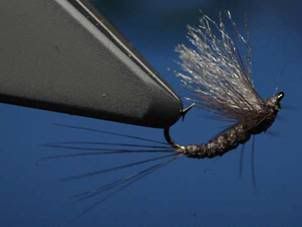In his book, In the Rings of the Rise, Vince Mariano describes a trout hanging in the water under a dry fly as it drifts. I have only ever known this happen in very smooth glides. In fast broken water the trout will slash at the fly, grabbing it before it gets away, in fast water what we call the chocolate biscuit (cookie) approach is most successful. (Take a child to McDonald's and feed him burgers and chips (fries) until they will not eat any more. Then wave a chocolate biscuit in front of them and see what happens!) For this we use flies like the Klinkhammer or Humpy.
In flat glides these flies give way to ones with a more accurate profile, such as Compara / Sparkle Duns, thorax duns, Petitjean Duns etc. As these flies only have to float on the glassy surface of a glide they do not need the kind of "floatability" (I use this term because it is imprecise) as the flies for broken water. They do however, need their profile. This is especially true if the trout hang under the fly inspecting it (if that is what they are doing) before deciding if they should take it or not.
When trout hang under a fly in this way the biggest problem facing the angler is how to maintain a drag free drift. Any well dressed fly, given an appropriate anointing of floatant, will float for long enough.
This leads me to ask, what is your fly (above) for? Is it for broken water? In which case there is little need for the delicate dressing. (Comparatively) big rough and ready flies work perfectly. Is it for the slow glides? In which case the extra foam on either side really isn't needed to float the fly, and only serves to ruin the outline of the fly.
Several years ago I experimented with using foam in dry flies. Here is one that incorporates closed cell foam but maintains a more lifelike silhouet.
There are still some of these flies in my box. I don't tie them anymore, because I don't fish them. I found that there was no gain in angling performance from using them. There was no return for the extra time and effort spent in tying them.
In just the same way, as I found with my foam flies, I don't think you will get any significant return on your investment in this fly. Of course all this depends on whether you view fly dressing as a part of angling, or as something completely separate. If you look in my fly boxes you will see that my fishing flies are different to the flies I tie commercially, generally they are simpler. The flies I tie for sale have to catch anglers, (fish don't pay for flies). The flies in my box are for catching fish.
Cheers,
A.




 Reply With Quote
Reply With Quote